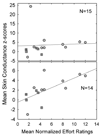Subjective and psychophysiological indexes of listening effort in a competing-talker task
- PMID: 21463566
- PMCID: PMC3072569
- DOI: 10.3766/jaaa.22.2.6
Subjective and psychophysiological indexes of listening effort in a competing-talker task
Abstract
Background: The effects of noise and other competing backgrounds on speech recognition performance are well documented. There is less information, however, on listening effort and stress experienced by listeners during a speech-recognition task that requires inhibition of competing sounds.
Purpose: The purpose was (a) to determine if psychophysiological indexes of listening effort were more sensitive than performance measures (percentage correct) obtained near ceiling level during a competing speech task, (b) to determine the relative sensitivity of four psychophysiological measures to changes in task demand, and (c) to determine the relationships between changes in psychophysiological measures and changes in subjective ratings of stress and workload.
Research design: A repeated-measures experimental design was used to examine changes in performance, psychophysiological measures, and subjective ratings in response to increasing task demand.
Study sample: Fifteen adults with normal hearing participated in the study. The mean age of the participants was 27 (range: 24-54).
Data collection and analysis: Psychophysiological recordings of heart rate, skin conductance, skin temperature, and electromyographic (EMG) activity were obtained during listening tasks of varying demand. Materials from the Dichotic Digits Test were used to modulate task demand. The three levels of task demand were single digits presented to one ear (low-demand reference condition), single digits presented simultaneously to both ears (medium demand), and a series of two digits presented simultaneously to both ears (high demand). Participants were asked to repeat all the digits they heard, while psychophysiological activity was recorded simultaneously. Subjective ratings of task load were obtained after each condition using the National Aeronautics and Space Administration Task Load Index questionnaire. Repeated-measures analyses of variance were completed for each measure using task demand and session as factors.
Results: Mean performance was higher than 96% for all listening tasks. There was no significant change in performance across listening conditions for any listener. There was, however, a significant increase in mean skin conductance and EMG activity as task demand increased. Heart rate and skin temperature did not change significantly. There was no strong association between subjective and psychophysiological measures, but all participants with mean normalized effort ratings of greater than 4.5 (i.e., effort increased by a factor of at least 4.5) showed significant changes in skin conductance.
Conclusions: Even in the absence of substantial performance changes, listeners may experience changes in subjective and psychophysiological responses consistent with the activation of a stress response. Skin conductance appears to be the most promising measure for evaluating individual changes in psychophysiological responses during listening tasks.
American Academy of Audiology.
Figures



Similar articles
-
Effects of hearing loss on heart rate variability and skin conductance measured during sentence recognition in noise.Ear Hear. 2015 Jan;36(1):145-54. doi: 10.1097/AUD.0000000000000091. Ear Hear. 2015. PMID: 25170782 Free PMC article.
-
Listening Effort by Native and Nonnative Listeners Due to Noise, Reverberation, and Talker Foreign Accent During English Speech Perception.J Speech Lang Hear Res. 2019 Apr 15;62(4):1068-1081. doi: 10.1044/2018_JSLHR-H-17-0423. J Speech Lang Hear Res. 2019. PMID: 30986135
-
Comparison of Psychophysiological and Dual-Task Measures of Listening Effort.J Speech Lang Hear Res. 2015 Dec;58(6):1781-92. doi: 10.1044/2015_JSLHR-H-14-0180. J Speech Lang Hear Res. 2015. PMID: 26363285
-
A Multimodal Approach to Measuring Listening Effort: A Systematic Review on the Effects of Auditory Task Demand on Physiological Measures and Their Relationship.Ear Hear. 2024 Sep-Oct 01;45(5):1089-1106. doi: 10.1097/AUD.0000000000001508. Epub 2024 Jun 17. Ear Hear. 2024. PMID: 38880960 Free PMC article.
-
Autonomic Nervous System Reactivity During Speech Repetition Tasks: Heart Rate Variability and Skin Conductance.Ear Hear. 2016 Jul-Aug;37 Suppl 1:118S-25S. doi: 10.1097/AUD.0000000000000305. Ear Hear. 2016. PMID: 27355761 Review.
Cited by
-
Interdisciplinary Approaches to the Study of Listening Effort in Young Children with Cochlear Implants.Audiol Res. 2021 Dec 21;12(1):1-9. doi: 10.3390/audiolres12010001. Audiol Res. 2021. PMID: 35076472 Free PMC article.
-
The Benefit of Hearing Aids as Measured by Listening Accuracy, Subjective Listening Effort, and Functional Near Infrared Spectroscopy.Trends Hear. 2024 Jan-Dec;28:23312165241273346. doi: 10.1177/23312165241273346. Trends Hear. 2024. PMID: 39195628 Free PMC article.
-
The Effects of Meaning-Based Auditory Training on Behavioral Measures of Perceptual Effort in Individuals with Impaired Hearing.Semin Hear. 2015 Nov;36(4):263-72. doi: 10.1055/s-0035-1564454. Semin Hear. 2015. PMID: 27587913 Free PMC article.
-
Quantifying the Effect of Noise on Cognitive Processes: A Review of Psychophysiological Correlates of Workload.Noise Health. 2022 Oct-Dec;24(115):199-214. doi: 10.4103/nah.nah_34_22. Noise Health. 2022. PMID: 36537445 Free PMC article. Review.
-
Brightening the Study of Listening Effort with Functional Near-Infrared Spectroscopy: A Scoping Review.Semin Hear. 2023 Apr 6;44(2):188-210. doi: 10.1055/s-0043-1766105. eCollection 2023 May. Semin Hear. 2023. PMID: 37122884 Free PMC article.
References
-
- Andreassi JL. Psychophysiology: Human behavior and physiological response. 5th edition. Mahwah, NJ: Lawrence Erlbaum; 2007.
-
- Apoux F, Crouzet O, Lorenzi C. Temporal envelope expansion of speech in noise for normal-hearing and hearing-impaired listeners: effects on identification performance and response times. Hear Res. 2001;153:123–131. - PubMed
-
- Arlinger S, Lunner T, Lyxell B, Pichora-Fuller MK. The emergence of cognitive hearing science. Scand J Psychol. 2009;50:371–384. - PubMed
-
- Backs RW, Seljos KA. Metabolic and cardiorespiratory measures of mental effort: The effects of level of difficulty in a working memory task. International Journal of Psychophysiology. 1994;16:57–68. - PubMed
-
- Baer T, Moore BCJ, Gatehouse S. Spectral contrast enhancement of speech in noise for listeners with sensorineural hearing impairement: effects on intelligibility quality, and response time. J Rehabil Res Dev. 1993;30:49–72. - PubMed
MeSH terms
Grants and funding
LinkOut - more resources
Full Text Sources
Medical
